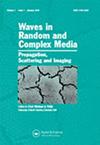塔塔斯基的强涨落理论:量子场论方法——一个关键性的评价
3区 物理与天体物理
Q1 Engineering
引用次数: 0
摘要
摘要本文采用量子场论方法对强涨落理论进行了批判性的研究[Tatarskii VI.湍流大气对波传播的影响]。耶路撒冷:IPST;1971]。利用Dyson方程和Bethe-Salpeter方程推导了辐射强度格林函数的辐射传递方程(RTE)。我们继续获得RTE的有效域的估计。所得结果既满足随机介质中波的光学定理,又满足能量守恒。我们还利用最近发展的尺度分离渐近理论推导了我们问题的RTE [Bal G., Komorowski T, Ryzhik L.]。[j].地理学报,2010;3(3):529 - 644。虽然两种方法得到的RTE是相同的,但我们解释了适用性制度,因此有效性条件是不同的。关键词:量子场论方法强涨落理论尺度分离渐近辐射传递方程随机媒体披露声明作者未报告潜在利益冲突。注1 d1和d2分别为空间变量r1和r2对应的Dyson算符(参见(Equation3(3)) D δ Gm= - δ(r−r′)(3))。2通过直接采用缩放格林函数的控制方程及其维格纳变换本文章由计算机程序翻译,如有差异,请以英文原文为准。
Strong fluctuation theory of Tatarskii: quantum field theoretic approach – a critical assessment
AbstractIn this paper, we carried out a critical investigation of the strong fluctuation theory using a quantum field theoretic approach [Tatarskii VI. The effects of the turbulent atmosphere on wave propagation. Jerusalem: IPST; 1971]. We employed the Dyson and Bethe-Salpeter equations to derive the radiative transfer equation (RTE) for the Green's function of the radiant intensity. We proceeded to obtain estimates of the domain of validity of the RTE. The results thus obtained satisfy both the optical theorem for waves in random media and energy conservation. We also derived the RTE for our problem by employing a recently developed scale-separated asymptotic theory [Bal G., Komorowski T, Ryzhik L. Kinetic limits of waves in random media. Kinet Relat Models. 2010;3:529–644]. Although the RTE obtained by the two approaches are identical, we explain that the applicability regimes, and hence validity conditions are different.Keywords: Quantum field theoretic approachstrong fluctuation theoryscale-separated asymptoticsradiative transfer equationsrandom media Disclosure statementNo potential conflict of interest was reported by the author(s).Notes1 Dˆ1 and Dˆ2 are Dyson operators (cf. (Equation3(3) DˆGm=−δ(r−r′)(3) )) corresponding to spatial variables r1 and r2, respectively.2 by directly employing the governing equations of scaled Green's functions and their Wigner transforms
求助全文
通过发布文献求助,成功后即可免费获取论文全文。
去求助
来源期刊

Waves in Random and Complex Media
物理-物理:综合
自引率
0.00%
发文量
677
审稿时长
3.0 months
期刊介绍:
Waves in Random and Complex Media (formerly Waves in Random Media ) is a broad, interdisciplinary journal that reports theoretical, applied and experimental research related to any wave phenomena.
The field of wave phenomena is all-pervading, fast-moving and exciting; more and more, researchers are looking for a journal which addresses the understanding of wave-matter interactions in increasingly complex natural and engineered media. With its foundations in the scattering and propagation community, Waves in Random and Complex Media is becoming a key forum for research in both established fields such as imaging through turbulence, as well as emerging fields such as metamaterials.
The Journal is of interest to scientists and engineers working in the field of wave propagation, scattering and imaging in random or complex media. Papers on theoretical developments, experimental results and analytical/numerical studies are considered for publication, as are deterministic problems when also linked to random or complex media. Papers are expected to report original work, and must be comprehensible and of general interest to the broad community working with wave phenomena.
 求助内容:
求助内容: 应助结果提醒方式:
应助结果提醒方式:


